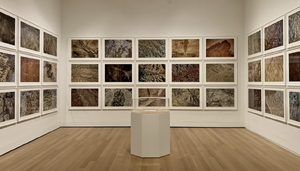Fazal Sheikh: Exposures
Artist: Fazal Sheikh
Year: 2022
Date of Action: September 2022
Region: North America
Location: Yale University, New Haven, Connecticut
Subject: Religion
Medium: Installation
Confronting Bodies: Yale University Art Gallery
Description of Artwork: Fazal Sheikh's exhibit "Exposures" intended to document the ways in which environmental racism impacted indigenous communities. The areas of focus ranged from Israel to the American Southwest. One project in particular titled "Exposure" examines the consequences of the indigenous communities' extractive mining practices.
Upon his research on site in the American Southwest, Sheikh became well acquainted with Navajo Diné elder, Jonah Yellowman, who has spent much of his life protected the sacred lands in Bears Ears, Utah. Yellowman gave Sheikh a gift, intending for it to be showcased amongst the rest of the work.
The gift was supposed to be part of the "In Place" section of the "Exposure" project, which focused on the beauty and preservation of the Four Corners region. The offering consisted of "a Navajo ceremonial basket, five cloth banners, one pouch white corn, one pouch cedar, one pouch sage, one packet eagle plumes, one packet lighting way ceremonial medicine, two packets mixed medicine, one arrowhead and one bone flute."
The Incident: The gallery chose to remove Yellowman's offering from the gallery. Instead, there is a pedestal with an empty case. Gallery director Stephanie Wiles stated that the gift had to have been properly requested in writing by her in order to receive the necessary permission to showcase it.
Sheikh and Yellowman were informed two months before the opening that the gift would not be displayed. The associate curator of photography Judy Ditner explained that the gallery consulted with advisors from Yale's Native community. Individuals explained that the gallery should not showcase sacred items, but Ditner wanted to have the empty case to symbolize and acknowledge Yellowman's gift. Yellowman explained that the ceremonial objects that he provided were "decoys" and not objects that were intended to actually be used in ceremonies. He explained that their purpose was purely educational to teach people about the Diné community, but the gallery's decision to remove the objects stood.
Results of Incident: Other associates at Yale have cited that if the gallery had decided to showcase these items, it would be comparable to the grave robbing and misappropriation that contributed to Yale's other collections.
Yellowman offered a second gift, one that consisted of no ceremonial objects. Upon disagreements on how to prepare the corn that was part of the gift to be shown, the second offering was never part of the gallery either. Following this conflict, Yellowman withdrew his involvement in the gallery completely after telling Sheikh that he felt "humiliated."
Policies that intended to respect the culture of indigenous communities ultimately resulted in an erasure of indigenous artifacts and perspectives. Sheikh considered removing all of his work from the gallery, but the gallery director's apology convinced him to allow his work to stay.
